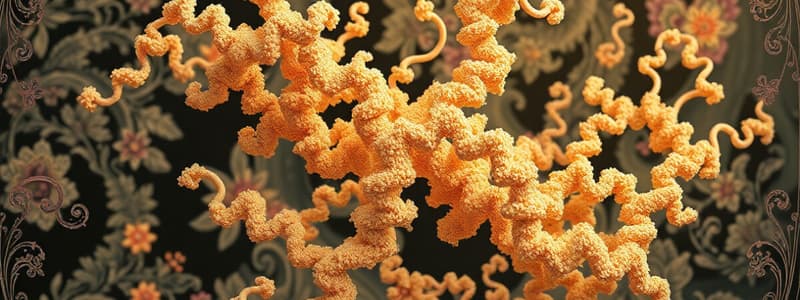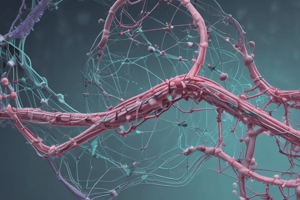Podcast
Questions and Answers
Which of the following is defined as the tertiary structure of a protein?
Which of the following is defined as the tertiary structure of a protein?
- the primary amino acid sequence
- structural features such as a turn
- folded structures such as an a helix
- structural domains such as a DNA-binding domain (correct)
Monomeric proteins do not contain a:
Monomeric proteins do not contain a:
- secondary structure
- primary structure
- quaternary structure (correct)
- tertiary structure
Which of the following is NOT part of a zinc-finger motif?
Which of the following is NOT part of a zinc-finger motif?
- proline residue (correct)
- histidine residue
- zinc ion
- cysteine residue
There are many important roles for the dynamic nature of proteins in a cell. Which of the following is NOT likely to describe one such reason?
There are many important roles for the dynamic nature of proteins in a cell. Which of the following is NOT likely to describe one such reason?
You are studying an oligopeptide composed of eight amino acids. The four amino acids nearest the C terminus are nonpolar. The two amino acids nearest the N terminus are charged. The middle two amino acids are polar. Which amino acid is likely to be labeled as number 2?
You are studying an oligopeptide composed of eight amino acids. The four amino acids nearest the C terminus are nonpolar. The two amino acids nearest the N terminus are charged. The middle two amino acids are polar. Which amino acid is likely to be labeled as number 2?
A protein containing several proline residues is:
A protein containing several proline residues is:
Which of the following is true about protein folding?
Which of the following is true about protein folding?
When comparing domains and structural motifs, which of the following is NOT true?
When comparing domains and structural motifs, which of the following is NOT true?
You disrupt all hydrogen bonds in a protein. What level of structure will be preserved?
You disrupt all hydrogen bonds in a protein. What level of structure will be preserved?
Two proteins that have a similar function:
Two proteins that have a similar function:
All the following statements about molecular chaperones are true EXCEPT:
All the following statements about molecular chaperones are true EXCEPT:
Hsp90 family members are present in all organisms EXCEPT:
Hsp90 family members are present in all organisms EXCEPT:
What role does aberrant protein folding play in the development of a disease such as Alzheimer's disease?
What role does aberrant protein folding play in the development of a disease such as Alzheimer's disease?
Which of the following does NOT impose limits on protein folding?
Which of the following does NOT impose limits on protein folding?
Eggs are protein-rich foods. An uncooked egg can catalyze a reaction that breaks down bacterial cell walls. After cooking, this activity is almost abolished. This is likely because:
Eggs are protein-rich foods. An uncooked egg can catalyze a reaction that breaks down bacterial cell walls. After cooking, this activity is almost abolished. This is likely because:
The correct order for molecular chaperone-mediated protein folding is:
The correct order for molecular chaperone-mediated protein folding is:
All the following statements about enzymes are true EXCEPT:
All the following statements about enzymes are true EXCEPT:
The K for an enzyme-catalyzed reaction:
The K for an enzyme-catalyzed reaction:
For an enzyme-catalyzed reaction, doubling the concentration of enzyme will:
For an enzyme-catalyzed reaction, doubling the concentration of enzyme will:
A small molecule that binds directly to the active site of an enzyme and disrupts its catalytic reaction is called:
A small molecule that binds directly to the active site of an enzyme and disrupts its catalytic reaction is called:
Changes in the conformational shape of an enzyme that diminish the size of its ligand-binding pocket are likely to affect an enzyme's:
Changes in the conformational shape of an enzyme that diminish the size of its ligand-binding pocket are likely to affect an enzyme's:
Which of the following is true about enzymes?
Which of the following is true about enzymes?
Which of the following plays a role in the degradation of proteins?
Which of the following plays a role in the degradation of proteins?
Which of the following modifications marks a protein for degradation in proteasomes?
Which of the following modifications marks a protein for degradation in proteasomes?
Protein self-splicing:
Protein self-splicing:
Proteases that attack selected peptide bonds within a polypeptide chain are synthesized and secreted as inactive forms called:
Proteases that attack selected peptide bonds within a polypeptide chain are synthesized and secreted as inactive forms called:
Which of the following is a mechanism for regulating protein activity?
Which of the following is a mechanism for regulating protein activity?
Protein kinase A is converted from an inactive state to an active state by binding:
Protein kinase A is converted from an inactive state to an active state by binding:
Kinases, which are responsible for the activation or inactivation of a number of proteins, add phosphate groups onto:
Kinases, which are responsible for the activation or inactivation of a number of proteins, add phosphate groups onto:
The conversion of inactive chymotrypsinogen to active chymotripsin is an example of:
The conversion of inactive chymotrypsinogen to active chymotripsin is an example of:
A misfolded protein targeted to the proteasome will undergo:
A misfolded protein targeted to the proteasome will undergo:
Modification of proteins by ubiquitin and ubiquitin-like E3 ligases can stimulate all of the following EXCEPT:
Modification of proteins by ubiquitin and ubiquitin-like E3 ligases can stimulate all of the following EXCEPT:
GTPases serve in many signal transduction pathways and the presence of GTP or GDP dictates whether the pathway is on or off, respectively. Which of the following statements is true regarding guanine nucleotide exchange factors (GEF) and their role in these signaling pathways?
GTPases serve in many signal transduction pathways and the presence of GTP or GDP dictates whether the pathway is on or off, respectively. Which of the following statements is true regarding guanine nucleotide exchange factors (GEF) and their role in these signaling pathways?
Which of the following methods can separate proteins based on their mass?
Which of the following methods can separate proteins based on their mass?
In two-dimensional gel electrophoresis, proteins are first resolved by ____ and then by ____
In two-dimensional gel electrophoresis, proteins are first resolved by ____ and then by ____
Gel filtration chromatography separates proteins on the basis of their:
Gel filtration chromatography separates proteins on the basis of their:
Starting with 1 mCi (milliCurie) of a phosphorus-32-labeled compound, how long would it take until only 0.125 mCi remains?
Starting with 1 mCi (milliCurie) of a phosphorus-32-labeled compound, how long would it take until only 0.125 mCi remains?
Western blotting is a method for detecting:
Western blotting is a method for detecting:
A chunk of tissue is treated so that each cell's membrane is broken open to release the contents inside, and then subjected to differential centrifugation. Which of the following is true at the end of the centrifugation?
A chunk of tissue is treated so that each cell's membrane is broken open to release the contents inside, and then subjected to differential centrifugation. Which of the following is true at the end of the centrifugation?
Proteomics allows researchers to:
Proteomics allows researchers to:
Mass spectrometry techniques are used in proteomics for all of the following purposes EXCEPT:
Mass spectrometry techniques are used in proteomics for all of the following purposes EXCEPT:
Flashcards
Tertiary protein structure
Tertiary protein structure
The three-dimensional arrangement of a protein's polypeptide chain.
Monomeric proteins
Monomeric proteins
Proteins composed of a single polypeptide chain.
Zinc-finger motif
Zinc-finger motif
A protein structural motif that includes a zinc ion and specific amino acid residues.
Primary protein structure
Primary protein structure
Signup and view all the flashcards
Secondary protein structure
Secondary protein structure
Signup and view all the flashcards
Quaternary protein structure
Quaternary protein structure
Signup and view all the flashcards
Coiled-coil motif
Coiled-coil motif
Signup and view all the flashcards
Helix-loop-helix motif
Helix-loop-helix motif
Signup and view all the flashcards
Hydrophobic interactions
Hydrophobic interactions
Signup and view all the flashcards
Molecular chaperones
Molecular chaperones
Signup and view all the flashcards
Aberrant protein folding
Aberrant protein folding
Signup and view all the flashcards
Enzyme
Enzyme
Signup and view all the flashcards
Enzyme kinetics
Enzyme kinetics
Signup and view all the flashcards
Competitive inhibitor
Competitive inhibitor
Signup and view all the flashcards
Proteasome
Proteasome
Signup and view all the flashcards
Ubiquitinylation
Ubiquitinylation
Signup and view all the flashcards
Zymogen
Zymogen
Signup and view all the flashcards
Proteolytic processing
Proteolytic processing
Signup and view all the flashcards
Allosteric effector
Allosteric effector
Signup and view all the flashcards
Positive cooperativity
Positive cooperativity
Signup and view all the flashcards
Two-dimensional gel electrophoresis
Two-dimensional gel electrophoresis
Signup and view all the flashcards
Gel filtration chromatography
Gel filtration chromatography
Signup and view all the flashcards
Western blotting
Western blotting
Signup and view all the flashcards
Study Notes
Protein Structure and Function
- Protein structure is defined by the primary, secondary, tertiary, and quaternary structures.
- The primary structure is the amino acid sequence, linked by peptide bonds.
- The secondary structure is stabilized by hydrogen bonds between atoms of the peptide backbone, and includes alpha helices and beta-sheets.
- The tertiary structure is stabilized by hydrophobic interactions between nonpolar side groups and hydrogen bonds between polar side groups.
- The quaternary structure is held together by noncovalent bonds between protein subunits.
- Zinc-finger motifs contain a zinc ion, cysteine and histidine residues, but not proline.
- Monomeric proteins lack the quaternary structure.
Protein Folding
- Proteins typically fold into specific 3D shapes determined by their amino acid sequence.
- Hydrophobic amino acids tend to cluster in the interior, while hydrophilic amino acids are on the surface.
- Protein folding is often aided by chaperones.
- Hydrogen bonds, ionic interactions, and hydrophobic interactions stabilize protein folding.
- Incorrect folding can lead to disease (e.g., Alzheimer's disease).
Protein Function and Regulation
- Enzymes speed up chemical reactions by lowering the activation energy.
- The active site of an enzyme binds to a substrate and catalyzes a reaction.
- The rate of enzyme catalyzed reaction depends on the concentration of substrate, temperature, and pH.
- Protein folding and function are often regulated by interactions with other molecules.
- Modification by small molecules (e.g., ubiquitination, phosphorylation) regulate protein activity.
- Protein degradation through proteases and proteasomes is part of normal cellular processes.
Protein Separation and Analysis
- Methods for separating proteins include gel filtration chromatography and SDS-PAGE.
- Two-dimensional gel electrophoresis separates proteins based on both charge and mass, allowing for a more detailed analysis of protein mixtures.
- Mass spectrometry can identify and quantify proteins in complex mixtures.
- Western blotting identifies specific proteins using antibodies and subsequent enzyme-based detection.
Studying That Suits You
Use AI to generate personalized quizzes and flashcards to suit your learning preferences.




